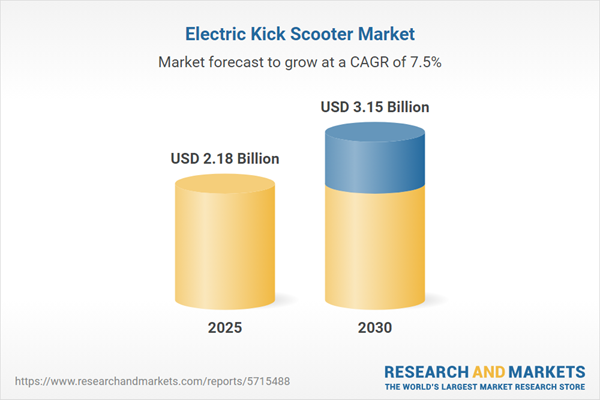Speak directly to the analyst to clarify any post sales queries you may have.
The electric kick scooter market is transforming urban mobility, driven by evolving user needs and rapid innovation, making it critical for senior decision-makers to access accurate, actionable insights to steer profitable growth and streamline operations.
Market Snapshot: Electric Kick Scooter Market Growth and Opportunity
From 2024 to 2030, the electric kick scooter market is projected to realize significant gains in overall valuation and post a solid compound annual growth rate (CAGR). This expansion is propelled by advancements in battery technologies, escalating adoption of micro-mobility solutions, and accelerating urbanization. As cities seek scalable last-mile transit, electric kick scooters are cementing their role as practical and sustainable choices for both commuters and enterprise users. This dynamic fuels ongoing diversification, investment, and innovation, reinforcing the sector’s influence within the broader urban mobility ecosystem.
Scope & Segmentation: Insights Across the Electric Kick Scooter Ecosystem
- Product Type: Two-wheeled and three-wheeled scooters address different user preferences for stability and application contexts.
- Category: Foldable models optimize portability for individual use; non-foldable variants emphasize durability for intensive and commercial deployment.
- Battery Type: Lithium-ion batteries are widely adopted for reduced weight and extended range. Lead-based batteries persist where upfront costs are prioritized.
- Range: Extended-range offerings target professional delivery and logistics, while smaller-range models address typical urban commuting needs.
- Voltage Range: Options cover ratings from below 24V up to above 48V, catering to varying speed requirements and load capacities.
- Speed: Multiple speed variants align with regulatory demands and use-case diversity, spanning commuter-friendly speeds and specialized high-performance models.
- Application: Products serve commercial delivery, private commuting, and recreational uses, encouraging adoption among businesses and consumers alike.
- End User: Models are engineered for safety and resilience, meeting the requirements of adult and youth segments.
- Distribution Channel: Distribution spans offline retail, direct OEM sales, and digital marketplaces, allowing for customization, flexibility, and responsiveness to changing buying trends.
- Geography: Market activity encompasses the Americas, Europe, Middle East & Africa, and Asia-Pacific, each with unique adoption drivers related to local infrastructure and evolving regulatory environments.
- Key Manufacturers: Apollo Scooters, Bird Global, Inc., Segway Inc. by Ninebot, Razor USA LLC, Xiaomi Corporation, and Yadea Technology Group Co., Ltd. are primary industry participants, shaping product innovation and quality benchmarks.
Key Takeaways: Strategic Insights for Industry Leadership
- Urban planners are expanding charging and dedicated mobility lanes, supporting smoother integration of electric kick scooters for efficient city transport.
- Manufacturers are leveraging modular platforms and connected technologies, improving adaptability for both large-scale shared fleets and individual owners.
- Advances in engineering target segment-specific durability and safety improvements, catering to distinct requirements from commercial operators to everyday riders.
- Local regulatory differences drive tailored product designs and deployment strategies, making regional expertise essential for sustainable rollout.
- Companies are broadening their revenue strategies with enhanced aftermarket services and integration within wider smart city systems, aligning with organizational and municipal priorities.
- The transition to direct-to-consumer channels and shared mobility frameworks is speeding up, offering new ways to reach and serve customers while enabling rapid adaptation to shifting market conditions.
Tariff Impact: Supply Chain and Production Adaptations
Changes in import tariffs have prompted industry participants to adjust sourcing and assembly plans by increasing investments in localized manufacturing hubs and regional supply chains. Modular component designs are streamlining compliance with regional standards, and strategic collaboration with trade organizations is becoming more central to achieving business continuity and identifying new growth opportunities.
Methodology & Data Sources
This market assessment draws on executive interviews across OEMs, key suppliers, and shared fleet operators, supplemented by end-user surveys focusing on safety and functionality. Regulatory filings, industry white papers, patent analysis, and broad urban mobility research form the evidence base to ensure actionable, decision-ready intelligence.
Why This Report Matters: Value for Senior Decision-Makers
- Helps optimize procurement and highlights priority areas for technology investment, strengthening the organization’s position in the electric kick scooter supply chain.
- Facilitates dynamic go-to-market strategies by spotlighting changing customer demands and evolving distribution channels.
- Equips leaders to anticipate regulatory shifts, mitigate supply chain risks, and reinforce operational strategies amid ongoing market change.
Conclusion
With continuous regulatory and technological change, robust intelligence is vital for organizations to seize market opportunities, minimize risk, and solidify long-term performance in the electric kick scooter industry.
Additional Product Information:
- Purchase of this report includes 1 year online access with quarterly updates.
- This report can be updated on request. Please contact our Customer Experience team using the Ask a Question widget on our website.
Table of Contents
3. Executive Summary
4. Market Overview
7. Cumulative Impact of Artificial Intelligence 2025
List of Figures
Samples

LOADING...
Companies Mentioned
The key companies profiled in this Electric Kick Scooter market report include:- Apollo Scooters
- Ausomstore
- Bird Global, Inc.
- Dualtron by Minimotors
- EMotorad by Inkodop Technologies Private Limited
- Gleev Motors Private Limited
- Glion by Dolly E-Scooters LLC
- GOTRAX
- GOVECS AG
- INOKIM NYC
- Jiangsu Xinri E-Vehicle Co.,Ltd
- Joyor E-Moving S.L.
- Levy Electric Inc.
- Maxfind by Klarna Inc.
- Mearth Technology Pty. Ltd.
- Megawheels
- Ningbo Kaabo Technology Co. Ltd.
- Niu International Co.,Ltd.
- Radboards
- Razor USA LLC
- Segway Inc. by Ninebot
- Swagtron
- Swifty Scooters Limited
- Unagi Inc.
- Xiaomi Corporation
- Yadea Technology Group Co.,Ltd
Table Information
| Report Attribute | Details |
|---|---|
| No. of Pages | 187 |
| Published | October 2025 |
| Forecast Period | 2025 - 2030 |
| Estimated Market Value ( USD | $ 2.18 Billion |
| Forecasted Market Value ( USD | $ 3.15 Billion |
| Compound Annual Growth Rate | 7.5% |
| Regions Covered | Global |
| No. of Companies Mentioned | 27 |









